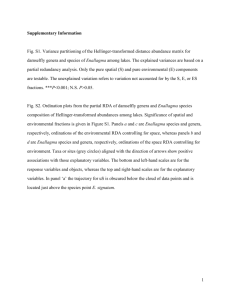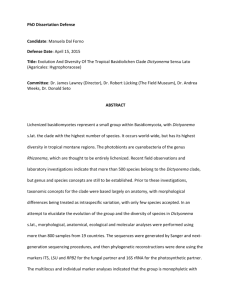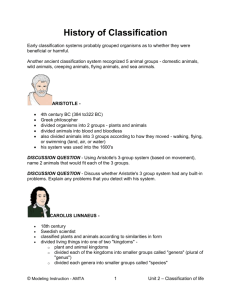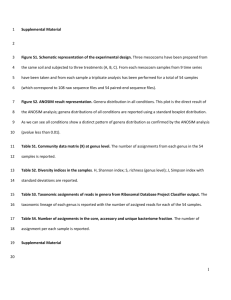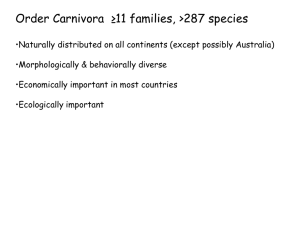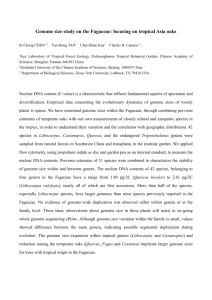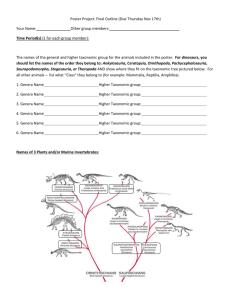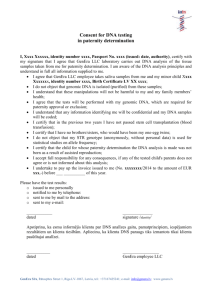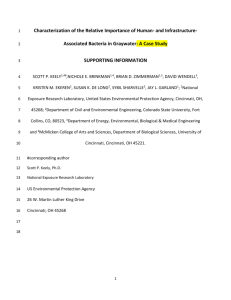Berg_Unpubl - Trinidad Birding
advertisement
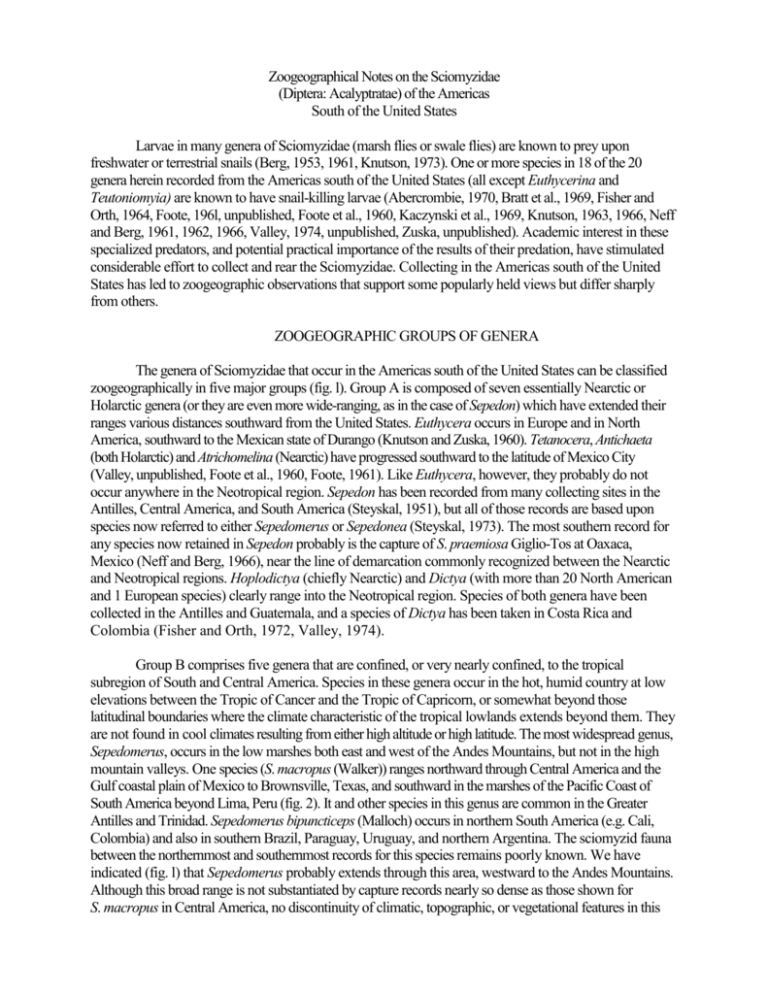
Zoogeographical Notes on the Sciomyzidae (Diptera: Acalyptratae) of the Americas South of the United States Larvae in many genera of Sciomyzidae (marsh flies or swale flies) are known to prey upon freshwater or terrestrial snails (Berg, 1953, 1961, Knutson, 1973). One or more species in 18 of the 20 genera herein recorded from the Americas south of the United States (all except Euthycerina and Teutoniomyia) are known to have snail-killing larvae (Abercrombie, 1970, Bratt et al., 1969, Fisher and Orth, 1964, Foote, 196l, unpublished, Foote et al., 1960, Kaczynski et al., 1969, Knutson, 1963, 1966, Neff and Berg, 1961, 1962, 1966, Valley, 1974, unpublished, Zuska, unpublished). Academic interest in these specialized predators, and potential practical importance of the results of their predation, have stimulated considerable effort to collect and rear the Sciomyzidae. Collecting in the Americas south of the United States has led to zoogeographic observations that support some popularly held views but differ sharply from others. ZOOGEOGRAPHIC GROUPS OF GENERA The genera of Sciomyzidae that occur in the Americas south of the United States can be classified zoogeographically in five major groups (fig. l). Group A is composed of seven essentially Nearctic or Holarctic genera (or they are even more wide-ranging, as in the case of Sepedon) which have extended their ranges various distances southward from the United States. Euthycera occurs in Europe and in North America, southward to the Mexican state of Durango (Knutson and Zuska, 1960). Tetanocera, Antichaeta (both Holarctic) and Atrichomelina (Nearctic) have progressed southward to the latitude of Mexico City (Valley, unpublished, Foote et al., 1960, Foote, 1961). Like Euthycera, however, they probably do not occur anywhere in the Neotropical region. Sepedon has been recorded from many collecting sites in the Antilles, Central America, and South America (Steyskal, 1951), but all of those records are based upon species now referred to either Sepedomerus or Sepedonea (Steyskal, 1973). The most southern record for any species now retained in Sepedon probably is the capture of S. praemiosa Giglio-Tos at Oaxaca, Mexico (Neff and Berg, 1966), near the line of demarcation commonly recognized between the Nearctic and Neotropical regions. Hoplodictya (chiefly Nearctic) and Dictya (with more than 20 North American and 1 European species) clearly range into the Neotropical region. Species of both genera have been collected in the Antilles and Guatemala, and a species of Dictya has been taken in Costa Rica and Colombia (Fisher and Orth, 1972, Valley, 1974). Group B comprises five genera that are confined, or very nearly confined, to the tropical subregion of South and Central America. Species in these genera occur in the hot, humid country at low elevations between the Tropic of Cancer and the Tropic of Capricorn, or somewhat beyond those latitudinal boundaries where the climate characteristic of the tropical lowlands extends beyond them. They are not found in cool climates resulting from either high altitude or high latitude. The most widespread genus, Sepedomerus, occurs in the low marshes both east and west of the Andes Mountains, but not in the high mountain valleys. One species (S. macropus (Walker)) ranges northward through Central America and the Gulf coastal plain of Mexico to Brownsville, Texas, and southward in the marshes of the Pacific Coast of South America beyond Lima, Peru (fig. 2). It and other species in this genus are common in the Greater Antilles and Trinidad. Sepedomerus bipuncticeps (Malloch) occurs in northern South America (e.g. Cali, Colombia) and also in southern Brazil, Paraguay, Uruguay, and northern Argentina. The sciomyzid fauna between the northernmost and southernmost records for this species remains poorly known. We have indicated (fig. l) that Sepedomerus probably extends through this area, westward to the Andes Mountains. Although this broad range is not substantiated by capture records nearly so dense as those shown for S. macropus in Central America, no discontinuity of climatic, topographic, or vegetational features in this 2 vast area of tropical lowlands would seem to suggest that the northern and southern populations of S. bipuncticeps are disjunct. Like Sepedomerus, Sepedonea also extends southward to Buenos Aires and curves around the northern end of the Andes to start southward in the tropical marshes west of the continental divide. However, Sepedonea has not been taken on the Pacific slope south of Cali, Colombia; it is not found in the Greater Antilles; and its known range extends northwestward on the mainland only to the lower end of Mexico. Thecomyia is more restricted than Sepedonea, being confined to Central America and South America east of the continental divide. Its range extends northwestward to Guatemala, southeastward through Venezuela and the Guianas to the south Brazilian State of Santa Catarina, and westward to the foothills of the Andes in Ecuador and Peru (G. C. Steyskal, in manuscript). Guatemalia is known only from southern Mexico, Guatemala, and Costa Rica. Capture records for Teutoniomyia suggest a widely disjunct distribution. One species has been collected only in Costa Rica; the other occurs at Rio de Janeiro and in the State of Santa Catarina, Brazil, and at Tucumán, Argentina. Group C is made up of five genera even more strictly confined to the temperate subregion of South America than Group B is to the tropical. Three genera range from the Pacific to the Atlantic coast south of the Tropic of Capricorn, and two of these extend far northward in the narrow belt of temperate climate in the Andes Mountains (fig. l). Perilimnia, the most wide ranging genus, dominates many collecting sites in cool, humid areas from the Strait of Magellan to the vicinity of Bogota, Colombia. Dichrochirosa has a similar range, but its northward extension in the mountains is not known to surpass Quito, Ecuador. All seven species assigned to Tetanoceroides occur in Chile, and all are confined to latitudes exceeding 27° south. Five species have been collected also in Argentina, and one has been taken in Uruguay (Zuska and Berg, 1974). Shannonia and Euthycerina range southward in Chile below the coastal deserts of the northernmost provinces. Neither is known from northern and central Argentina, where the mountains on the Chile-Argentine boundary are high enough to constitute an effective barrier. South of 40°S latitude, however, where the low mountain passes permit migration, species of both genera have been collected in the Argentine province of Rio Negro, and we have taken Shannonia also in Chubut and Santa Cruz (Kaczynski et al., 1969). Protodictya and Dictyodes, the only genera in addition to Pherbellia that breed extensively in both tropical and temperate subregions of South America, are placed together in Group D. The range of Protodictya extends from Mexico through Central America, Venezuela, and Brazil to southern Chile and Patagonia. It apparently does not include either the mountains of Colombia, Ecuador, and Peru or the coastal marshes west of them. At least five species are confined to tropical habitats in Central America, Venezuela, and Brazil. One species, P. chilensis Malloch, occurs only in temperate portions of Chile and Argentina; two species, P. guttularis (Wiedemann) and P. lilloana Steyskal, evidently breed with equal success in both subregions. The north-to-south range of Dictyodes is much less extensive, but it is almost equally divided between tropical and temperate subregions in southern Brazil (north to Rio de Janeiro), Bolivia, and eastern Argentina (south to Buenos Aires and Tandil). Group E, widely distributed through both North and South America, is represented solely by the nearly cosmopolitan genus Pherbellia. The distribution of this genus in the Western Hemisphere stretches through 123 degrees of latitude — from Prudhoe Bay on the Arctic coast of Alaska, to Tierra del Fuego. Species of Pherbellia are less common in tropical than in both north-temperate and south-temperate zones, but they occur in scattered tropical habitats in the Antilles, Central America, and both east and west of the Andes Mountains in South America. We are following Steyskal (1949) in using the generic name Pherbellia in the broad sense, 3 although further study of this large taxon may result in its being split into several genera. A policy of nomenclatural conservatism in this matter seems prudent until a worldwide study of all species assigned to Pherbellia can be made. Proposed generic segregations of some European species, made without benefit of such an extensive study, have not been adopted by subsequent workers. For this and other reasons, we are not now adopting the generic names Notopherbellia, Melina, and Pseudomelina, applied by Malloch (1933) and Stuardo Ortiz (1946) to the Patagonian sciomyzid fauna. Melina Robineau-Desvoidy, 1830 is preoccupied by Melina Retzius, 1788 (Mollusca). Other names used by Malloch and Stuardo Ortiz but not by us are Notosciomyza (a junior synonym of Perilimnia) and Sciogriphoneura (a genus of Dryomyzidae). DISCUSSION Students of the Neotropical fauna have stated that South America can be divided into sharply defined tropical and temperate subregions, the latter extending northward across the equator in a narrow belt of high elevation in the Andes Mountains. Fittkau (1969: fig. 1, p. 643) showed the "AndeanPatagonian" subregion protruding northward in the mountains almost up to the equator. Kuschel (1969: fig. 1, p. 711) extended this temperate subregion even farther north — across the equator, through Colombia, and into western Venezuela. His line of demarcation between the "Patagonian" (temperate) and "Brazilian" (tropical) subregions (fig. 2) is based on distribution patterns of Coleoptera in various families. It separates the ranges of the South American Sciomyzidae remarkably well. Ten of the 12 sciomyzid genera endemic to the Neotropical region are, with minor exceptions, confined to one subregion or the other. No species in any of the five genera in Group C has been collected on the tropical side of that line. Only two species in Group B, Sepedomerus bipuncticeps (Malloch) and Sepedonea lindneri (Hendel), are known to occur on the temperate side of it, in a relatively small area of overlap from Buenos Aires north to southern Brazil. Only the three genera assigned to Groups D and E have extensive ranges on both sides of Kuschel's line, and most of the species even in those genera occur only on one side, or on the other, of this line. The sharp segregation of temperate and tropical species is illustrated by two species that occur in close proximity over 20 degrees of latitude but have never been found together (fig. 2). Perilimnia albifacies Becker, which has by far the greatest range of any species in Group C, is widely distributed in lowlands as well as the mountains from the southern tip of South America northward to approximately 25ºS latitude. North of the Tropic of Capricorn, this species is confined to the cool intermontane valleys, but in those valleys its range extends northward through Bolivia, Peru, Ecuador, and part of Colombia. The larva of this species is predatory on aquatic, pulmonate snails of various genera (Kaczynski et al., 1969). Sepedomerus macropus (Walker) is probably extending its range from a point of origin in Central America. Although it has spread southward through the hot, humid marshes on the Pacific coast of Colombia, Ecuador, and most of Peru, it evidently has not invaded the intermontane valley habitats of P. albifacies in those countries. Most of the collecting sites shown for P. albifacies in the narrow belt of high elevation in the mountains, and most of the sites indicated (fig. 2) for S. macropus on the narrow coastal plain west of it, are sites where we have collected. In all of those marshes, enough effort was made to support the conclusion that S. macropus is not present in the intermontane valleys and P. albifacies is not present in the coastal marshes. The larva of S. macropus is also predatory on various aquatic pulmonates, but the larvae live in different microhabitats, and their adaptations and modes of life are quite different (cf. Neff and Berg, 1966 and Kaczynski et al., 1969). 4 Distribution patterns of the Sciomyzidae thus lend strong support both to the sharp division of South America into subregions and to the northward extension of the temperate subregion across the equator. The ranges of Perilimnia and Dichrochirosa, and their evident conformation to ranges of the temperate species of Coleoptera studied by Kuschel, indicate that the climatic conditions optimal to both beetles and flies extend far northward, but only in a narrow belt of high elevation in the mountains. Additional evidence of this long, narrow "peninsula" of temperate conditions is found in the exclusion of a tropical genus such as Sepedomerus, which evidently surrounds it on both sides and one end, but nowhere intrudes into it. The Sciomyzidae also give strong support to the statement (e.g. Fittkau, 1969) that the South American fauna is unusually rich in endemic species. In the Sciomyzidae, there is a high proportion of endemism even on the generic level. Twelve of the 14 genera found in South America, all genera in Groups B, C, and D, are essentially endemic to the Neotropical region. (This counts Sepedomerus as a Neotropical endemic, although S. macropus has been collected as far north as Brownsville, Texas.) The only genera found in the mainland of South America that breed extensively in other zoogeographic regions are Dictya and Pherbellia. The species of Dictya collected in Colombia and Costa Rica is a Neotropical endemic, as are most of the species of Pherbellia found in South America. The conclusion that the fauna of South America has developed undisturbed and well isolated from other continents seems inescapable. Authors have reported that a high proportion of the Chilean fauna is endemic to that country. Peña (1966) and Artigas (1970) both stated that Chile has a distinctive "fauna of its own". Because of deserts on Chile's border with Peru and high mountain chains on her border with Bolivia and much of Argentina, the fauna of Chile is more distinctive than that of most continental nations having such extensive perimeters. However, the impression of high endemism probably has been exaggerated because of limited collecting in much of Argentina. It seems almost certain that more collecting effort, especially in southwestern Argentina, will reduce considerably the number of species that would now be listed as Chilean endemics. The mountains from about 40°S latitude to the southern tip of the continent are not very high, and there the Chilean "... forests of Nothofagus and Araucaria and their associated faunas extend into the Argentine territories ..." (Peña, 1966). Although Tetanoceroides was considered a primarily Chilean genus, five of the seven species are now known also from Argentina (Zuska and Berg, 1974). Seven of the eight species of Sciomyzidae most commonly collected in the marshes near Santiago occur also in Argentina. Judging solely on the Sciomyzidae, one would have to conclude that the endemism of Chile on the species level is not nearly so remarkable as the endemism of Latin America, on the genus level. For example, Protodictya chilensis Malloch is not endemic to Chile, but its genus is endemic to the Neotropical region. The same statement can be made concerning at least nine other Chilean species of Sciomyzidae. Several students of Patagonian insects (e.g. Brundin, 1966, Illies, 1969) have concluded that their closest phylogenetic relationships are with the faunas of Australia and Hew Zealand. These relationships in the Chironomidae seemed so strong to Fittkau that he wrote (1969), "... a Mesozoic areal connection — at least between part of South America and Australia-New Zealand — has become a conceptual necessity." However, we cannot see any phylogenetic relationship between the sciomyzid fauna of Patagonia and that of Australia and New Zealand. Only one of the five subfamilies occurs in both regions, and that subfamily (Sciomyzinae) is practically cosmopolitan. The only genus found in both Patagonia and Australia (Pherbellia) is represented by strikingly different species in these two regions. The Pherbellia of Australia are obese, heavy-bodied flies with darkly pigmented bodies and wings. Their larvae habitually pupate inside the shells of the last snails they consume (Berg, unpublished). By contrast, Pherbellia patagonensis (Macquart) and other Patagonian species are slender flies with immaculate 5 wings, light pigmentation of the body, and structural characters completely different from those of the Australian Pherbellia. Their larvae also pupate in the shells of their last victims, but this habit has evolved several times and is found in other genera of Sciomyzini as well as Pherbellia; it must be considered adaptive and without phylogenetic significance. However, the North American P. humilis (Loew) is morphologically so similar to P. patagonensis, and both are so similar to the European P. grisescens (Meigen), that both American species were once sunk in synonymy under P. grisescens. They were resurrected as valid species (Steyskal, 1963) only after a careful comparison of male genitalia. Perhaps significantly, the range of P. humilis extends southward to Costa Rica; it seems that this species might well have given rise to P. patagonensis. The endemic Neotropical genera also show close relationships with Nearctic genera and probably were derived from them: Sepedomerus, Sepedonea, and Thecomyia with Sepedon; Guatemalia and Tetanoceroides with Tetanocera; Shannonia and Perilimnia with Tetanocera or perhaps Antichaeta (but these are probably the most distinctive of the Neotropical genera and the hardest to associate positively with any other sciomyzid genus); Protodictya and Dictyodes with Dictya; Teutoniomyia with Dictyacium; Dichrochirosa with Pteromicra; and Euthycerina with Euthycera. A conclusion of Darlington (1957:449) may be as applicable to the Sciomyzidae as to the vertebrates that he wrote about: "In short, the whole existing Neotropical vertebrate fauna is a mixture of surviving parts of an old, endemic Tertiary fauna . . . and a new fauna received via North America." In the Sciomyzidae, the old, endemic Neotropical genera probably also came from North America. A statement of Simpson (1943:417) seems equally applicable to the Sciomyzidae: "Many of the earlier immigrants from North America have been in South America long enough to develop distinctive genera (but not families) there and even the later migrants among mammals are, as a rule, specifically distinct in the Neotropical Region." However, we do not debate statements that the primitive Chironomidae, Plecoptera, and Ephemeroptera of Patagonia may have their closest relatives in the Australian region. The origins of those ancient groups are believed to go back to the Triassic, Permian, and Pennsylvanian periods. If so, and if Gondwanaland did not divide until late Triassic or early Jurassic, those groups may have been widespread in Gondwanaland before the rift of that early continent occurred. However, the Sciomyzidae probably had not evolved at that time. The finding of five species in Baltic amber (Hennig, 1965) proves that they go back to the Oligocene, but it is doubtful if they or any other acalyptrate family arose much earlier than that. After making an extensive study of the Diptera in Canadian amber (Cretaceous), J. F. McAlpine states (personal communication) that he has found nothing that would qualify as a true acalyptrate. So postulation of a Mesozoic land bridge between Patagonia and Australia- New Zealand for the acalyptrate Diptera would be as pointless as for the mammals, and for the same reason -- neither group was here then to utilize it.
